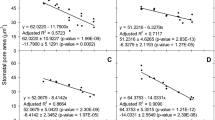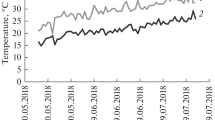Abstract
Experiments involving 14 accessions of Panicum miliaceum L. (Proso millet) and 11 accessions of Setaria italicaL. (Foxtail millet) have demonstrated variability in the degree of osmoregulative capacity among these accessions. Birdseed millet is generally claimed to be sensitive to drought stress, apparently because of a shallow root system. Accessions with high osmoregulative capacity demonstrate at least some drought tolerance. Osmoregulative capacity was measured on flag leaves of headed millet plants in pots undergoing water stress in a controlled environment chamber. Osmoregulative capacity was determined from the relationship between osmotic potential and leaf water potential; and the logarithmic relationship between osmotic potential and relative water content. The group of accessions of S. italica showed an overall level of osmoregulative capacity which was greater than that observed for the group of P. miliaceum accessions. Four accessions of S. italica(108042, 108463, 108541 and 108564) and one accession of P. miliaceum (108104)demonstrated high osmoregulative capacity. Differences of 1.05 MPa or more between observed and estimated osmotic potential were found at relative water contents of80 % among these accessions. The extent of osmoregulative capacity was associated with osmotic potential at full turgor and the rate of decline in osmotic potential as leaf water potential declined.
Similar content being viewed by others
References
Allard, R. W. (1960) Relationship between genetic diversity and consistency of performance in different environments, Crop Sci. 1, 127–133.
Brown, J. K. M. and Jørgensen, J. H. (1991) A catalogue of mildew resistance genes in European barley varieties, in J. Helms Jørgensen, Integrated Control of Cereal Mildews: Virulence Patterns and Their Change, pp. 263–286. Riso National Laboratory, Roskilde, Denmark.
Chin, K. M. and Wolfe, M. S. (1984) The spread of Erysiphe graminis f. sp. hordei in mixtures of barley varieties, Plant Pathol. 33, 89–100.
Clarkson, J. D. S. and Slater, S. E. (1996) Mildew of barley, United Kingdom Cereal Pathogen Virulence Survey Annual Report for 1995, pp. 34–43.
Czembor, J. H. and Gacek, E. S. (1996) The use of cultivar and species mixtures to control diseases and for yield improvement in cereals in Poland, in E. Limpert, M.R. Finckh and M.S. Wolfe (eds), Integrated Control of Cereal Mildews and Rusts: Towards Co-ordination of Research Across Europe, pp.177–184, Proc. Workshop COST 817, Zürich 5–10 Nov 1994, European Commission, Luxembourg, 276 p.
Czembor, H. J. and Czembor, H. J. (1998) Powdery mildew resistance in cultivars of spring barley from Polish register, Plant Breeding and Cereal Science 42, 87–99.
Finckh, M. R. and Mundt, C. C. (1992a) Stripe rust, yield and plant competition in wheat cultivar mixtures, Phytopathology 82, 905–913.
Finckh, M. R. and Mundt, C. C. (1992b) Plant competition and disease in genetically diverse wheat populations, Oecologia 91, 82–92.
Finckh, M. R., Gacek, E. S., Goyeau, H., Lannou, C., Merz, U., Mundt, C. C., Munk, L., Nadziak, J., Newton, A. C., de Vallavieille-Pope, C., and Wolfe, M. S. (2000) Cereal cultivar and species mixtures in practice, Agronomie: Plant Genetics and Breeding 20, 813–837.
Gacek E. and Nadziak, J. (1988) Yield and susceptibility to powdery mildew (Erysiphe graminis f.sp. hordei) in cultivar mixtures of winter barley, Biuletyn Instytutu Hodowi i Aklimatyzacji Roslin 165, 5–14.
Gacek, E. S., Czembor, H. J., and Nadziak, J. (1996a) Disease restriction, grain yield and its stability in winter barley cultivar mixtures, in E. Limpert, M. R. Finckh and M. S. Wolfe (eds), Proceedings of the Third Workshop on Integrated Control of Cereal Mildews Across Europe, Kappel a. Albis, Switzerland, 5–9 Nov. 1994, pp. 185–190, European Commission DGXII, Brussells.
Gacek, E. S., Finckh, M. R., and Wolfe, M. S. (1996b) Disease control and yield effects in spring feed and malting barley mixtures in Poland, in E. Limpert, M. R. Finckh and M.S. Wolfe (eds), Proceedings of the Third Workshop on Integrated Control of Cereal Mildews Across Europe, Kappel a. Albis, Switzerland, 5–9 Nov. 1994, pp. 203–208, European Commission DGXII, Brussells.
Gacek, E. S., Strzembicka, H., and Wegrzyn, S. (1996c) Mixtures of spring wheat: their influence on powdery mildew and grain yield, in E. Limpert, M.R. Finckh and M. S. Wolfe (eds), Proceedings of the Third Workshop on Integrated Control of Cereal Mildews Across Europe, Kappel a. Albis, Switzerland, 5–9 Nov. 1994, pp. 193–196, European Commission DGXII, Brussells.
Gieffers, W. and Hesselbach, J. (1988) Disease incidence and yield of different cereal cultivars in pure stands and mixtures. I. Spring barley (Hordeum vulgare L.), Zeitschrift für Flanzenkrankheiten und Pflanzenschutz 95, 46–62.
Goleniewski, G. and Newton, A. C. (1994) Modelling mildew spread in cereal mixtures using a nearest neighbour approach: the effect of geometrical arrangement, Plant Pathol. 43, 631–643.
Huang, R., Kranz, J., and Welz, H. G. (1994) Selection of pathotypes of Erysiphe graminis f. sp. hordei in pure and mixed stands of spring barley, Plant Pathol. 43, 458–470.
Jeger, M. J., Griffiths, E., and Jones, D. G. (1981) Disease progress of non-specialised fungal pathogens in intraspecific mixed stands of cereal cultivars. I. Models, Ann. Appl. Biol. 98, 187–198.
Mundt, C. C. and Browning, J. A. (1985) Development of crown rust epidemics in genetically diverse oat populations: effect of genotype unit area, Phytopathology 75, 607–610.
Newton, A. C. (1997) Cultivar mixtures in intensive agriculture, in I. R. Crute, J. Burdon and E. Holub (eds), Gene-for-gene relationship in plant parasite interactions, pp. 65–80, CAB International, Wallingford, Oxford.
Newton, A. C. and Hackett, C. A. (1994) Subjective components of mildew assessment on spring barley, Eur. J. Plant Pathol. 100, 395–412.
Newton, A. C., Ellis, R. P., Hackett, C. A., and Guy, D. C. (1997) The effect of component number on Rhynchosporium secalis infection and yield in mixtures of winter barley cultivars, Plant Pathol. 45, 930–938.
Newton, A. C., Swanston, J. S., Guy, D. C., and Ellis, R. P. (1998) The effect of cultivar mixtures on malting quality in winter and spring barley, J. Inst. Brew. 104, 41–45.
Newton, A. C. and Swanston, J. S. (1999) Cereal variety mixtures reducing inputs and improving yield and quality – why isn't everybody growing them? Scottish Crop Research Institute Annual Report for 1998.
Newton, A. C., Guy, D. C., Gaunt, R. E., and Thomas, W. T. B. (2000) The effect of powdery mildew inoculum pressure and fertiliser level on disease tolerance in spring barley, J. Plant Dis. Prot. 107, 67–73.
Prasad, R., Singh, S., Sharma, S. N., and Singh, C. P. (1988) Studies on pure and mixed stands of wheat and barley under dryland agriculture conditions, J. Agron. Crop Sci. 160, 335–338.
Slater, S. E. and Clarkson, J. D. S. (1998) Mildew of barley, United Kingdom Cereal Pathogen Virulence Survey Annual Report for 1997, pp. 43–51.
Snedecor, G. W. and Cochran, W. G. (1980) Statistical Methods, Seventh edition, Iowa State University Press, Ames, Iowa, USA, 507 pp.
Stuke, F. and Fehrmann, H. (1988) Plant pathological aspects in winter cultivar mixtures, Zeitschrift für Pflanzenkrankheiten und Pflanzenschutz 95, 531–543.
Swanston, J. S., Gacek, E., Guy, D. C., and Newton, A. C. (2000) Malting performance of barley cultivar mixtures from the UK and Poland, J. Inst. Brew. 106, 239–243.
Tottman, D. R. (1987) The decimal code for cereal growth stages with illustrations, Ann. Appl. Biol. 110, 441–454.
Wolfe, M. S. and Barrett, J. A. (1980) Can we lead the pathogen astray? Plant Dis. 64, 148–155.
Wolfe, M. S. and Finckh, M. R. (1997) Diversity of host resistance within the crop: effects on host, pathogen and disease, in H. Hartleb, R. Heitefuss and H. H. Hoppe (eds), Resistance of crop Plants, pp. 378–400, Gustav Fischer Verlag.
Zhu, Y., Chen, H., Fan, J., Wang, Y., Li, Y., Chen, J., Fan, J., Yang, S., Hu, L., Leung, H., Mew, T. W., Teng, P. S., Wang, Z., and Mundt, C. C. (2000) Genetic diversity and disease control in rice, Nature 405, 718–722.
Author information
Authors and Affiliations
Corresponding author
Rights and permissions
About this article
Cite this article
Karyudi, Fletcher, R. Osmoregulative capacity in birdseed millet under conditions of water stress. I. Variation in Setaria italica and Panicum miliaceum . Euphytica 125, 337–348 (2002). https://doi.org/10.1023/A:1016073910886
Issue Date:
DOI: https://doi.org/10.1023/A:1016073910886




